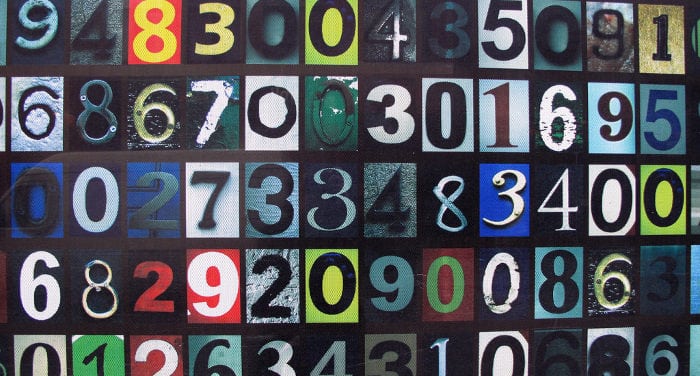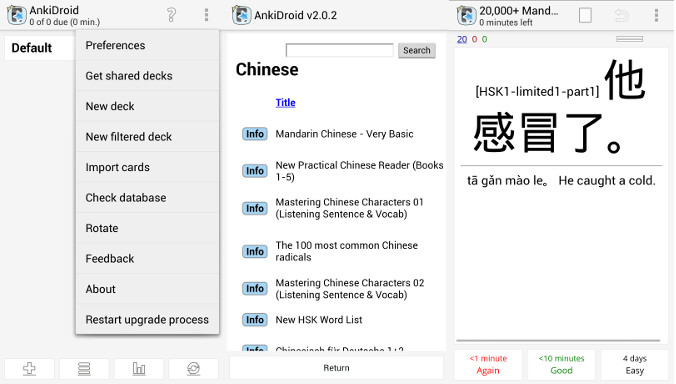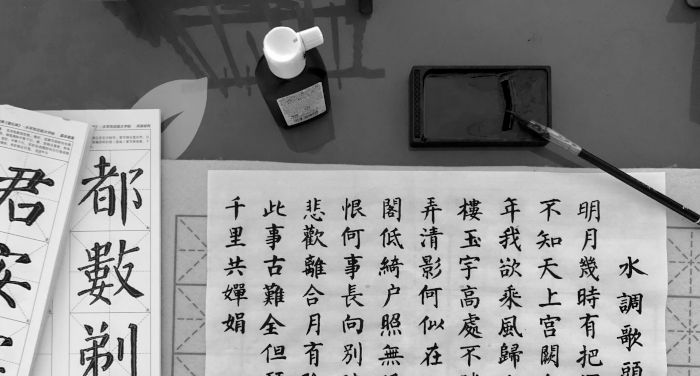
Before speaking about classifiers, it’s good to review the numbers 1 to 10 because they are indispensable for numerical constructions:
1: 一 (yī)
2: 二 (èr)
3: 三 (sān)
4: 四 (sì)
5: 五 (wǔ)
6: 六 (liù)
7: 七 (qī)
8: 八 (bā)
9: 九 (jiǔ)
10: 十 (shí)
Classifiers
Now that we’ve reviewed numbers, we can get going on our main talking point: classifiers.
In Chinese, when formulating numeric or quantitative expressions, such as “two books”, “three notebooks”, “five pens”, the number must be followed by a character which is traditionally called a classifier.
There are hundreds of classifiers that vary according to the noun that they must – appropriately – classify. For example, if we want to say “three books” after the number there must be a specific classifier for the readable objects.
Keeping in mind that the classifier for the readable objects (books, novels) is 本 (běn), the phrase “three books” will be formed this way:
三本书。
Sān běn shū.
Note that when using the number 2 in numerical constructions, it will no longer be 二 (èr), but 两 (liǎng). The reason why is that the nominal syntagm “two books”, is said as 两本书 and not 二本书 in Chinese.
Another basic thing to know is that there are some nouns that do not require the use of a classifier. For example, 年 (nián) year and 天 (tiān) day. For which, “one day” will be 一天 (yī tiān) and “one year” will be 一年 (yī nián).
A basic verb for composing the first phrases is 有 (yǒu), which means “to have/to have been”:
他有五本书。
Tā yǒu wǔ běn shū.
He has five books.
她有两本书。
Tā yǒu liǎng běn shū.
She has two books.
When you can’t remember the appropriate classifier for a noun, in extreme cases you can go to a so-called generic classifier: 个 (ge).
三个人。
Sān ge rén.
Three people.
两个学校。
Liǎng ge xuéxiào.
Two schools.
There are tons of classifiers and the main problem for a foreigner isn’t so much knowing them all but rather using them in speech that is more written than spoken. For convenience, below we’ve listed a “short” list with some of the most-used classifiers.
List of most commonly used classifiers
把 (bǎ) is used for objects with handles that can be taken or lifted with one hand such as: dāo 刀 (knife),chā 叉(fork),sháo 勺(spoon),yǐzi 椅子(seat), yǔsǎn 雨伞 (umbrella),yáshuā 牙刷 (toothbrush),yàoshi 钥匙 (key).
yī bǎ dāo 一把刀 (one knife),liǎng bǎ chā 两把叉 (two forks),liǎng bǎ sháo 两把勺 (two spoons),wǔ bǎ yǐzi 五把椅子 (five seats).
本 (běn) is used for paper objects composed of several pages, like: shū书 (book),zázhì 杂志 (magazine),liànxíběn 练习本 (notebook).
liǎng běn shū 两本书 (two books),sān běn zázhì 三本杂志 (three magazines),qī běn liànxíběn 七本练习本 (seven notebooks).
场 (chǎng) is used for sporting competitions and shows, but also for rain and snow: bǐsài 比赛 (race),yīnyuèhuì 音乐会 (concert),diànyǐng 电影 (film), yǔ 雨 (rain),xuě 雪 (snow).
yī chǎng diànyǐng 一场电影 (one film),liǎng chǎng bǐsài 两场比赛 (two games).
滴 (dī), which means “drop” is used for yǎnlèi 眼泪 (tear),shuǐ 水 (water),hàn 汗 (sweat),jiǔ 酒 (alcohol).
yī dī shuǐ 一滴水 (a drop of water),liǎng dī yǎnlèi 两滴眼泪 (two tears).
幅 (fú) is used for leaves and paintings: chātú 插图 (illustrations),huà 画 (painting).
yī fú chātú 一幅插图 (one illustration),liǎng fú huà 两幅画 (two paintings).
个 (ge), as already mentioned, is a generic classifier for human beings, three-dimensional objects, abstract things and when you can’t remember the most appropriate classifier: rén 人 (person),jīdàn 鸡蛋 (egg),liànxí 练习 (exercises).
sān ge rén 三个人 (three people),liǎng ge jīdàn 两个鸡蛋 (two eggs).
根 (gēn) is used for long objects that are more or less thin, rigid or flexible like: zhēn 针 (needle),zhùzi 柱子 (column),tóufa 头发 (hairs),zhúzi 竹子 (bamboo).
liǎng gēn zhúzi 两根竹子 (two bamboo reeds).
架 (jià) is used for larger items and machines such as: fēijī飞机 (airplane),gāngqín 钢琴 (piano), lùyīnjī 录音机 (recorder),shōuyīnjī 收音机 (radio).
sān jià fēijī 三架飞机 (three airplanes).
件 (jiàn) is used for clothing that covers the upper half of the body, for business and gifts like: chènshān 衬衫 (shirt),dàyī 大衣 (jacket),máoyī 毛衣 (sweater), shì 事 (thing, business), lǐwù 礼物 (gift).
liǎng jiàn máoyī 两件毛衣 (two sweaters),yī jiàn chènshān 一件衬衫 (one shirt).
棵 (kē), which means “plant”, is the classifier for all trees and some herbs and vegetables, for example: shù 树 (tree),sōngshù 松树 (pine),liǔshù 柳树 (willow),lúhuì 芦荟 (aloe),báiyáng 白杨 (poplar),báicài 白菜 (Chinese cabbage).
liǎng kē shù 两棵树 (two trees),yī kē báicài 一颗白菜 (one Chinese cabbage).
颗 (kē), which means grain, is used for objects with a granular form like: zhēnzhū 珍珠 (pearl),xīng 星 (star),zǐdàn 子弹 (bullet),zhàcài 榨菜 (mustard tuber),xīn 心 (heart).
liǎng kē zhēnzhū 两颗珍珠 (two pearls),sān kē zǐdàn 三颗子弹 (three bullets).
口 (kǒu), which means “mouth”, is used for zhū 猪 (pork) and jǐng 井 (well). It is also used for utensils such as: guō 锅 (pot), gāng 缸 (vase, jar). 口kǒu (mouth) it is also preferred as a classifier for the number of family members:
sì kǒu rén 四口人 (four people).
块 (kuài), which means “piece” or “slice”, is used for pieces big and small of something that at times can be translated into Italian:
yị̄ kuài dàngāo 一块蛋糕 (a slice of cake).
粒 (lì), which means “grain” or “kernel”, is used for smaller objects in granular form that require the above-cited 颗 (grain) as a classifier:
yī lì mǐ 一粒米 (a grain of rice), sān lì kāfēidòu 三粒咖啡豆 (three coffee beans).
辆 (liàng), which means “vehicle, is used for ground vehicles (military or civilian) like: chē 车 (vehicle), qìchē 汽车 (automobile), tǎnkè 坦克 (tank), sānlúnchē 三轮车 (rickshaw).
yī liàng tǎnkè 一辆坦克 (one tank).
门 (mén), which means “door” is used for kǎoshì 考试 (test), kè 课 (material, lesson), kèchéng 课程 (course of study).
liǎng mén kǎoshì 两门考试 (two tests).
篇 (piān), which means “section”, is used for written things that aren’t too long like wénzhāng 文章 (article), gùshi 故事 (story), but also for bìyè lùnwén 毕业论文 (graduate thesis).
yī piān lùnwén 一篇论文 (one thesis).
片 (piàn), which means “thin slice”, is used for 树叶 (leaf), miànbāo 面包 (bread), but also indicates vast extensions of the earth or water such as 大海 (see) or píngyuán 平原 (plain).
sān piànmiàn bāo 三片面包 (three slices of bread).
袭 (xí) is a very formal classifier used for referring to complete suits.
yīxí qípáo 一袭旗袍 (one Qipao).
首 (shǒu), which means “head”, is used for 诗 (poem), gē 歌 (song), yuèqǔ 乐曲 (musical work).
liǎng shǒu gē 两首歌 (two songs).
所 (suǒ) is used for buildings, in particular with dàxué 大学 (university).
liǎng suǒ dàxué 两所大学 (two universities).
艘 (sōu) is used for ships and boats like chuán 船 (boat), yóulún 游轮 (cruise ship), dùchuán 渡船 (ferry), jūnjiàn 军舰 (warship), yóulún 油轮 (tanker) e yúchuán 渔船 (fishing boat).
liǎng sōu yóulún 两艘油轮 (two tankers).
条 (tiáo), which means “streak” is mainly used for long things that aren’t straight or rigid such as hé 河 (river), shé 蛇 (snakes), yú 鱼 (fish), lǐngdài 领带 (tie), qúnzi 裙子 (skirt), kùzi 裤子 (pants), kùchǎ 裤衩 (underwear), wéijīn 围巾 (scarf) and tóujīn 头巾 (headscarf).
shí tiáo shé 十条蛇 (ten snakes).
头 (tóu) is used for large quadruped animals like zhū 猪 (pig), niú 牛 (cow), shīzi 狮子 (lion), hǔ 虎 (tiger), xióng 熊 (bear), xióngmāo 熊猫 (panda), dàxiàng 大象 (elephant), bào 豹 (leopard).
wǔ tóu shīzi 五头狮子 (five lions).
位 (wèi) is only used for people to whom you feel a certain respect.
yī wèi jiāoshòu 一位教授 (one university professor).
张 (zhāng), which means “leaf”, is used for objects in leaf form or flat objects such as zhǐ 纸 (paper), piào 票 (ticket), kǎpiàn 卡片 (sheet), chàngpiàn 唱片 (disc), zhàopiàn 照片 (photo), huà 画 (painting), hǎibào 海报 (poster), zhuōzi 桌子 (tavolo), chuáng 床 (table), guāngpán 光盘 (DVD), xīnpiàn 芯片 (microchip).
yī zhāng zhuōzi 一张桌子 (one table).
只 (zhǐ) is used for many animals such as gǒu 狗 (dog), láng 狼 (wolf), dàxiàng大象 (elephant), māo 猫 (cat), shīzi 狮子 (lion), chángjǐnglù 长颈鹿 (giraffe), lạ̌ohǔ 老虎 (tiger), dàishǔ 袋鼠 (kangaroo), xióngmāo 熊猫 (panda) and for each piece of a pair, like xiézi 鞋子 (shoes), wàzi 袜子 (socks), shǒutào 手套 (gloves), shǒu手 (hands).
yi zhi mao 一只猫 (one cat), yi zhi xiezi 一只鞋子 (one shoe), yi zhi wazi 一只袜子 (one sock), yī zhǐ shǒutào 一只手套 (one glove).
支 (zhī), which means “little stick”, is used for thin, straight, rigid objects like qiānbǐ 铅笔 (pencil), yuánzhūbǐ 圆珠笔 (ballpoint pen), xiāngyān 香烟 (cigarette), bǐ 笔 (pen).
yī zhī bǐ 一支笔 (one pen).
匹 (pǐ) is used for mǎ 马 (horses) and for luózi 骡子 (mules).
sān pǐ mǎ 三匹马 (three horses).
杯 (bēi), which means “cup”, is actually used with the meaning “cup”, such as:
yī bēi shuǐ 一杯水 (one cup of water),yī bēi kělè 一杯可乐 (one cup of cola).
瓶 (píng), which means “bottle”, is used in its original meaning of “bottle”:
yī píng shuǐ 一瓶水 (a bottle of water).
碗 (wǎn), which means “bowl”, in the same “bottle and “cup” are used with their original meaning:
liǎng wǎn mǐ 两碗米 “two bowls of rice”.
批 (pī), which means “consignment”, “lot”, or “group”, is used for something in large quantities, in particular with huò 货 / huòwù 货物 (goods), xuésheng 学生 (students).
yī pī huòwù 一批货物 (a consignment of goods).
座 (zuò) is used for mountains, buildings and all that doesn’t lean solidly on a floor, like fángzi 房子 (building), gōngyù 公寓 (condominium), liángqiáo 梁桥 (bridge), zhōnglóu 钟楼 (bell tower), shān 山 (mountain).
liǎng zuò shān 两座山 (two mountains), yī zuò liángqiáo 一座梁桥 (one bridge).
帮 (bāng) / 伙 (huǒ), which means “group” or “band” is used for groups of rén 人 (people), qiángdào 强盗 (bandits), liúmáng 流氓 (thugs).
yī̠ huǒ rén 一伙人 (one group of people).
套 (tào), which means “series” or “set”, is used for fángzi 房子 (in this case, “apartment”), jiāju 家具 (furniture), chájù 茶具 (tea service), gōngjù 工具 (utensils).
yī tào jiāju 一套家具 (one furniture set), liǎng tào fángzi 两套房子 (two apartments).
副 (fù) is used for inseparable couples like yǎnjìng 眼镜 (eyeglasses) and shǒutào 手套 (gloves).
yī fù yǎnjìng 一副眼镜 (one pair of glasses), yī fù shǒutào 一副手套 (one pair of gloves).
对 (duì) is used for couples that voluntarily unite like fūqī 夫妻 (spouses), qínglǚ 情侣 (lovers).
yī duì fūqī 一对夫妻 (one couple of husband and wife).
群 (qún) is used for groups, herds, packs, swarms, flocks and so forth. For example with lù 鹿 (deer), cāngying 苍蝇 (flies), mìfēng 蜜蜂 (bees), niú 牛 (cows).
yī qún cāngying 一群苍蝇 (one swarm of flies).
部 (bù) is used for artistic works or any other cultural products like 电影 (film) and xiǎoshuō 小说 (novel).
yī bù diànyǐng 一部电影 (one film).
双 (shuāng) is used for pairs that can be separated, like kuàizi 筷子 (chopsticks), xiézi 鞋子 (shoes).
yī shuāng kuàizi 一双筷子 (a pair of chopsticks).
栋 (dòng) / 幢 (zhuàng) is interchangeably used for buildings. The only difference is that the buildings quantified with dòng 栋 are taller.
yī dòng lóu 一栋楼 (one building), yī zhuàng lóu 一幢楼 (one building).
台 (tái) is used for small and medium-sized items such as shōuyīnjī 收音机 (radio), lùyīnjī 录音机 (recorder).
liǎng tái shōuyīnjī 两台收音机 (two radios).
间 (jiān) is used for local housing like wūzi 屋子 (room), wòshì 卧室 (bedroom), chúfáng 厨房 (kitchen) and shūfáng 书房 (studio).
sān jiān wūzi 三间屋子 (three rooms), yī jiān wòshì 一间卧室 (one bedroom).
The classifiers are a particularity of the Chinese language and the Japanese as well. They’re very difficult to learn and even harder to master. But nothing is impossible with strength and courage!




Thank you for explaining something that has confused me for ages. More please !!
Soon there will be more
This is an excellent post! More please, on the Chinese language.
Thanks Meghan, more posts are coming don’t worry